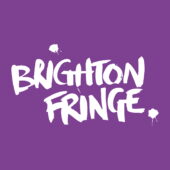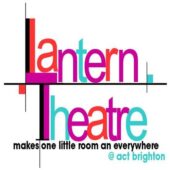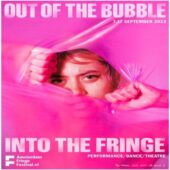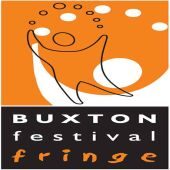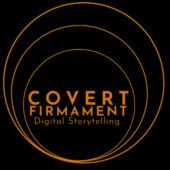The guest blog of ANDREW ALLEN
Andrew is a writer, performer and director. He is the founder of Cast Iron Theatre and Iron Clad Improv

WHAT’S THAT COMING OVER THE HILL? (Wednesday 25th July, 2017)
Listen. Can you hear it? Just there. That’s the elevated heartbeat and rather-too-rapid blinking of eyes of a thousand and more young (and sometimes not so young) creatives who have just checked their calendars and realised that we are now truly in the backend of July. The monolithic, unavoidable beast that is the Edinburgh Festival Fringe is nearly here, and there’s nothing any of us can do to avoid it.
There is, of course: we could avoid it altogether. We could genuinely choose an entirely different career altogether. We could do something that has reasonable hours, or – you know – has an outside chance of actually paying you sometime this month. This is of course, an entirely sensible option, but if you’re the sort of person to spend your spare time reading a blog you found on an online theatre review site, I imagine your instinctive reaction is one of bewilderment or even cold sweats.
I myself have been up to the fringe a few times before. But never as a producer or a performer – always as a member of the audience. In recent years, I’ve sullied that purity somewhat by becoming a reviewer – although I do have some pretty ‘pure’ ideas about how critics should behave – – but clearly, I’ve always wanted to bring something up here. We’ll chat in a future blog about precisely what my motives were (and are), but it remains true that you can’t spend more than a few days in the city during August without getting a little bit itchy, and fantasising about what you’d do with such-and-such a venue if given half the chance. When people asked me when I was going to start producing a show at the fringe, I would always wryly respond that I didn’t have that much money to lose that much money at Edinburgh.
This is actually still true, and yet I find myself producing a show. Part of the reason is that misery truly loves company, and Cast Iron Theatreisn’t just me: the co-artistic director (also my wife) is Michelle Donkin, and we’ve decided to do the insane thing together. Well, not just us, because there’s the show itself – Cacophony, which is a one woman show exploring aspects of clowning, mime and sound effect (yes, you’re not the first person to suggest that those three things don’t necessarily go together). The one woman in our one woman show is Heather-Rose Andrews, who we’ve been lucky with to work with on a number of occasions in various Cast Iron Theatre Short Play nights. It is, for all of us, our first year producing at the fringe, so obviously we’re treating this almost as a R&D trip: scoping out how it actually feels to do a show, how quickly it will drive us insane. Basically, we’re saying this is Year Zero, and that next year will be our ‘first’ year at Edinburgh.
So obviously we’re doing the entire month.
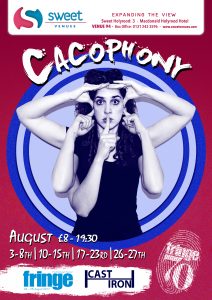
We had our first (and only) preview of the show last Saturday (July 22nd) at the DukeBox Theatre in Brighton, which will be our first (and only) chance to test drive the show in front of real humans before we take it up to Sweet Venues in August. We’re going to chat in this blog a little about how the show is going, what buzz we’re hearing from other productions, the people we’re meeting in the Cast Iron Theatre Podcast, and exactly when we’re down to our last bag of pasta and tinned tomatoes. Indeed, if you’re passing through Edinburgh with your own production during August, and you want to be featured on the Cast Iron Theatre Podcast, please get in touch, and we’ll see if our diaries match.

Oh, which reminds me. We’re attempting to raise some funds for our show via IndieGoGo – you know, like all the cool kids are these days. I’m acutely aware of differing opinions on this sort of thing – some feel it’s the only way to get funding in the current climate, while others get a little nettled, declaring that in their day, they simply worked every weekend for whatever cash they could save. It’s a discussion that we’ll unpick more in a future blog, but obviously I come down pretty firmly in the former camp, so much so that I’m telling anybody who will listen (and a healthy number who stopped listening quite some time ago) about the fundraising page we’ve set up for Cacophony. It’s reasonably unlikely that we’ll reach our intended target in time, but with IndieGoGo, we do get to keep whatever we do raise. To give you a nice sense of heightened tension, by the time you read this blog, we’ll be down to the last few hours before our deadline.
In the meantime, best of luck for your own shows, your own companies, your own sanity. See you in a week.
Hell, it’s only a week …
ALL OF US IN THE GUTTER
Up at the Edinburgh Fringe, star ratings are everything. At least, that’s what we keep being told in opinion pieces like this one. Obviously, they’re useful to plaster on the promotional material when indecisive potential audiences are drowning in flyers on the Royal Mile or panicking outside the Half Price Hut. The problem is, of course, that nobody nowadays seems to listen to – or even have basic respect for – any star rating below four. Which makes the whole thing nonsensical.
In all honesty, there’s nothing essentially wrong with star ratings, it’s just that absolutely nobody – with no exceptions whatsoever – knows how to employ them. Three star ratings are now a badge of dishonour, and there isn’t a theatre company who would feel happy using them in its press. This, clearly, is just a little bit silly: it suggests that the absolute baseline of credibility is four stars and above, ignoring anything below. That means we ignore almost 75% of the possible opinion. That’s like saying that nobody under the age of fifty is worth listening to. Yes, I’m well aware that some of you have no problem with that. But we’re missing out here. The very existence of three stars at the end of a review should indicate something of value. Three stars worth of value, in fact. Hell, you don’t even get three stars on your badge in McDonald’s without seriously impressing the management.
Let’s look at things in reverse order. Five stars is the easiest to discuss, since, like standing in a line at for a show at the fringe that doesn’t have relatives of members of the company in it, it’s simply near-impossible to achieve. Five stars should be indicative of the very best of someone’s career: literally, it can’t get any better than this. That being said, we’ve all been guilty of throwing away five stars when we probably shouldn’t have. Even I have to confess doing so when overtired, distracted by a pretty face in a supporting role, and jacked up on far too many Tangtastics.
Following that then, is Four Stars. Four Stars is what we should be calling unmissable, what a few too many of us actually think is a five star rating. These are the shows that we excitedly tweet about on the way out, of the venue, the ones that we recommend to our friends when the show tours locally. But they are still not five stars. A four star show is merely excellent. Excellent is something to be proud of. What’s happened, of course, is that in recent years, we have got ourselves trapped in a ‘X Factor’ mentality – apparently, things have to be life changingly brilliant, or grimly awful. We’ve become embarrassed by thinking anything in between. We are now bewilderingly shy of being able to rave about something that we find wonderful while at the same time acknowledging that it needs improvement.
If all the above is true (cough: it is), this means that Three Stars is not, as we have tricked ourselves into believing, mundane and invisible, a rating to be embarrassed by. No, three stars is – or, in my not so humble opinion, should be – simply a very good show. As I’ve argued before, in any other industry you have to work damn hard to get three stars. Soldiers returning from battle are continually baffled by the amount of young dance troupes petulantly rejecting their three stars at the fringe.
If we accept that a three star rating is actually a hard-won compliment rather than a dismissal, then two and one star ratings can begin to make a lot more sense. A two star rating is for a show that is essentially sound, but fatally or near-fatally flawed by a couple of bad choices: perhaps the lead is horrifically miscast, or the dialogue is overwritten. What those two stars tell you however (or, should tell you, in this alternate universe I’ve just made up), particularly in an environment as volatile and cauldron-bubbly as the fringe, is that although this show has some way to go before improvement, it is still worth your time: the company deserves your attention and feedback so that they can continue to grow.
Which leaves us with the one star review. In this version of the world, a one star review would be exactly what it should sound like: a show with at least some merit. Yes, a one star show would be undeniably poor. It might be incoherent, or the jokes would be indistinguishable from the twitter feed of that old school friend you keep meaning to delete – but that one star would suggest that there was at least one saving grace: intelligent direction, perhaps, attempting to throw light on a half-baked script, or a clever set design.
I understand completely that I’m a lone voice. The star ratings aren’t going anywhere anytime soon unless you write – as I indeed do – for a site like FringeReview, which has adopted a policy of ‘if you can’t beat them, then refuse point blank to join them’, and has eschewed star ratings altogether. Equally, for those sites and publications that are still using star ratings, companies are only ever going to be interested in ratings of four and five, which, as I’ve pointlessly argued is insane. So it’s down to us to argue more eloquently in our reviews. Now, I’ve been known to dismiss myself as an online hack, but what I’m hacking still has some merit. Well, if not merit, certainly weight. Reviews are at their best when they are a discussion, the development of the reviewer’s own reaction to whatever it is they have seen in the theatre. It’s not good that we can have our arguments and thoughts reduced down into what is essentially a very unimaginative line of emojis. If star ratings are like a reviewer’s version of Schrödinger’s Cat – simultaneously meaningless and vital – then what we write below the line needs to be carefully considered. Lest we forget, the reviewers themselves can now punished (or rewarded) with star-style ratings, via sites like FringePig. A few more of those plastered over reviewer’s profiles could do more to change the ratings system than anything else ..
Andrew Allen, 13th August 2015




